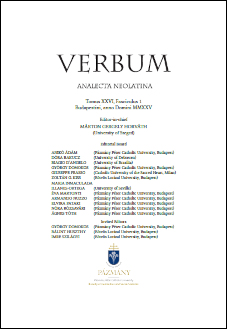Publiée 07/10/2025
Mots-clés
- sintassi,
- passive,
- modale,
- deontico,
- verbi di movimento
Comment citer

Ce travail est disponible sous la licence Creative Commons Attribution 4.0 International .
Résumé
In italiano l’ausiliare ‘andare’ viene utilizzato sia come ausiliare passivo al posto di ‘essere’, sia come ausiliare passivo modale (di tipo deontico). I due usi hanno proprietà diverse, esaminate qui sulla scorta di lavori precedenti e su nuove evidenze. L’uso puramente passivo di ‘andare’ è soggetto a maggiori restrizioni rispetto all’uso passivo modale deontico. Tra queste la combinazione con i soli verbi di ‘perdita’ e ‘scomparsa’, e l’impossibilità di esprimere un agente. In questo lavoro particolare attenzione è rivolta all’uso passivo modale deontico.
Références
- Bertinetto, P. M. (199) Il verbo. In L. Renzi & G. Salvi, eds., Grande grammatica italiana di consultazione, Vol. 2. 13–161. Bologna: Il Mulino.
- Bourdin, P. (2014) When come and go go necessive. In M. Devos & J. van der Wal, eds., COME and GO off the Beaten Grammaticalization Path. 103–164. Berlin: de Gruyter.
- Cinque, G. (1999) Adverbs and Functional Heads. A Cross-Linguistic Perspective. New York: Oxford University Press. https://www.academia.edu/58433772/Adverbs_and_Functional_Heads
- Cinque, G. (2003) The Interaction of Passive, Causative, and Restructuring in Romance. In C. Tortora, ed., The Syntax of Italian Dialects. 50–66. New York: Oxford University Press. https://www.academia.edu/58613374/Interaction_of_Passive_Causative_and_Restructuring_in_Romance
- Cinque, G. (2023) On Linearization. Toward a Restrictive Theory. Cambridge, Mass.: MIT Press. https://direct.mit.edu/books/oa-monograph/5553/On-LinearizationToward-a-Restrictive-Theory
- Ernout, A. & F. Thomas. 1964. Syntaxe Latine. Paris: Librairie C. Klincksieck.
- Giacalone Ramat, A. 2000. On some grammaticalization patterns for auxiliaries. In J. C. Smith & D. Bentley, eds., Historical Linguistics 1995. Vol. I: General issues and non-Germanic languages. 279–300. Amsterdam: Benjamins.
- Grochowska-Reiter, A. (2020) Ausiliari del passivo nella didattica dell’italiano LS. Studia Romanica Posnaniensia 47/2: 33–46. https://www.academia.edu/44091555/Ausiliari_del_passivo_nella_didattica_dellitaliano
- Herczeg, G. 1966. La locuzione perifrastica andare + participio passato. Lingua Nostra XXVII: 58–64.
- Ishizuka, T. & H. Koopman (2014) On the importance of being silent or pronounced; English -able and Japanese -are potentials compared. Glow poster. https://linguistics.ucla.edu/wp-content/uploads/2017/04/On-the-importance-of-being-silent-or-pronounced.-English-able-and-Japanese-rare-potentials-compared.pdf
- Ishizuka, T. & H. Koopman (2023) On the similarities and differences between Japanese -rare potentials and passives. Ms., UCLA.
- Krapova, I. & G. Cinque. 2008. On the order of wh-phrases in Bulgarian multiple wh-fronting. In G. Zybatow, L. Szucsich, U. Junghanns & R. Meyer, eds., Formal Description of Slavic Languages: The Fifth Conference, Leipzig 2003. 318–336. Frankfurt am Main: Peter Lang. https://citeseerx.ist.psu.edu/viewdoc/download?doi=10.1.1.528.4215&rep=rep1&type=pdf
- Leone, A. (1966) Ancora su “andare + participio passato”. Lingua Nostra XVII: 117–121
- Lepschy, A. L. & G. Lepschy (1988) The Italian Language Today. London: Hutchinson.
- Lo Cascio, V. (1968) Struttura, funzione, valore di andare + participio passato. Lingua e stile 3: 271–293
- Mocciaro, E. (2014) Passive in motion: the Early Italian auxiliary andare (‘to go’). In M. Devos & J. van der Wal, eds., COME and GO off the Beaten Grammaticalization Path. 45–68. Berlin: de Gruyter.
- Peruzzi, E. (1958) Problemi di grammatica italiana. Torino: ERI.
- Rizzi, L. (2018) Intervention effects in grammar and language acquisition. Probus 30 (2): 339–367
- Salvi, G. (1980) Gli ausiliari “essere” e “avere” in italiano. Acta Linguistica Academiae Scientiarum Hungaricae 30: 137–162
- Salvi, G. (1988) La frase semplice. In L.Renzi (a cura di) Grande grammatica italiana di consultazione. Vol.1. 29–113. Bologna: Il Mulino.
- Sansò A. & A. Giacalone Ramat (2016) Deictic Motion Verbs as Passive Auxiliaries: The Case of Italian Andare ‘Go’ (and Venire ‘Come’). Transactions of the Philological Society 114: 1–24. https://onlinelibrary.wiley.com/doi/epdf/10.1111/1467-968X.12059
- Squartini, M. (1999) Voice clashing with aspect: The case of Italian Passives. Rivista di Linguistica 11(2): 341–365. https://www.italian-journal-linguistics.com/app/uploads/2021/06/5_Squartini.pdf
- Van Molle-Marechal, P. (1974) “Andare” e “venire” ausiliari del passivo. In M. Medici & A. Sangregorio (a cura di) Fenomeni morfologici e sintattici nell’italiano contemporaneo. Volume primo. Tomo secondo. 357–372. Roma: Bulzoni.

